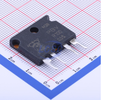Hi all,
I am trying to repair this Bentham power supply.
The FETs keep on blowing up. I have replaced them and same problem - I've measured everything else and it seems to be fine when compared against the datasheets. I have also checked for shorts and cannot find anything.
I am connecting a lamp between "red" and "black" on the right side of the schematic and it's supposed to give 12V when connected (we have another unit that is working).
When the FETs were replaced, they started at 12V, but then slowly ramped up to 38V and blew the lamp.
Any suggestions to why this may be happening?
![605 Circuit diagram[6006].jpg 605 Circuit diagram[6006].jpg](https://www.electro-tech-online.com/attachments/605-circuit-diagram-6006-jpg.140219/)
I am trying to repair this Bentham power supply.
The FETs keep on blowing up. I have replaced them and same problem - I've measured everything else and it seems to be fine when compared against the datasheets. I have also checked for shorts and cannot find anything.
I am connecting a lamp between "red" and "black" on the right side of the schematic and it's supposed to give 12V when connected (we have another unit that is working).
When the FETs were replaced, they started at 12V, but then slowly ramped up to 38V and blew the lamp.
Any suggestions to why this may be happening?



